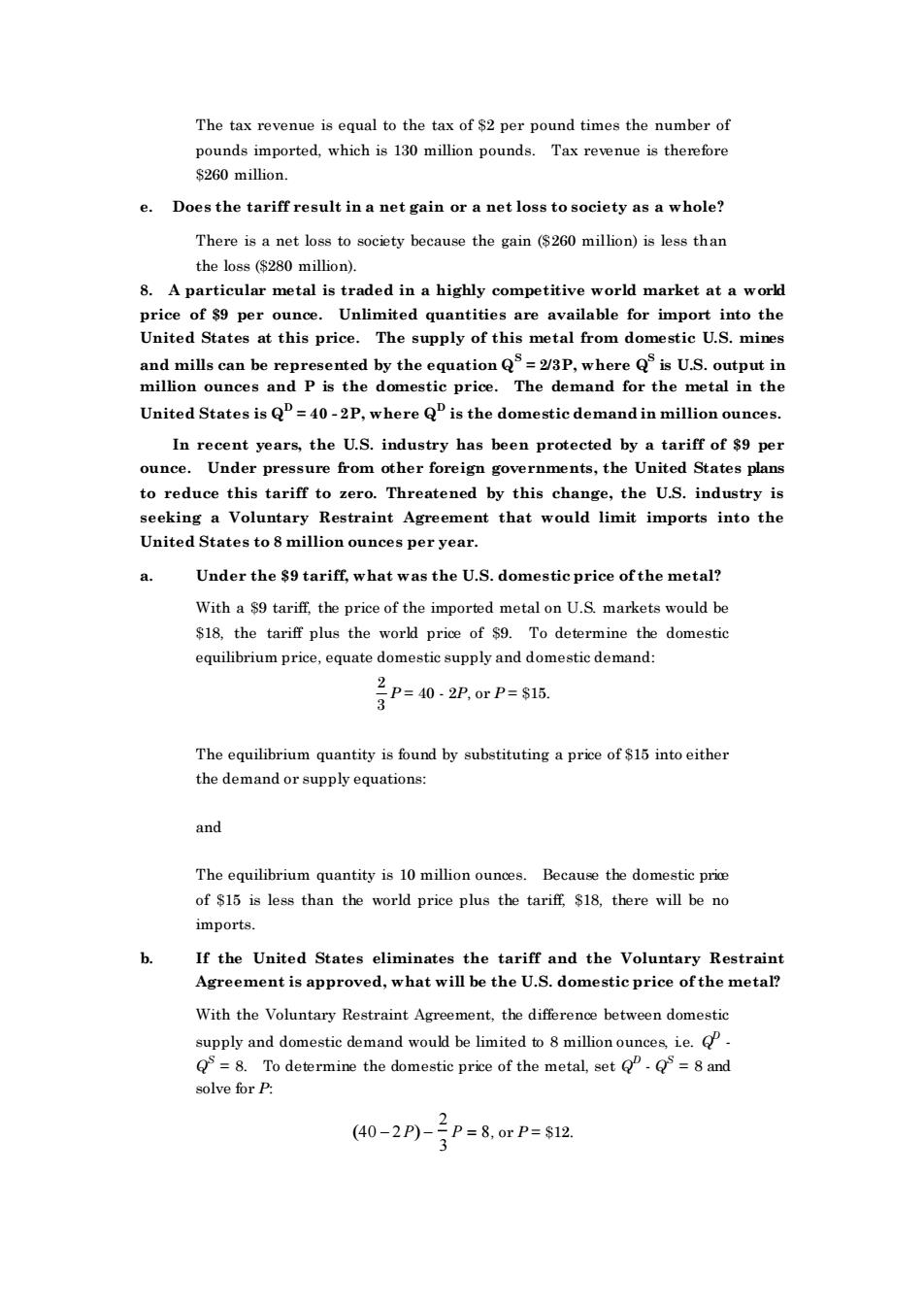正在加载图片...

The tax revenue is equal to the tax of $2 per pound times the number of Tax revenue is therefore $260 million Does the tariff result in a net gain or a net loss to society as a whole? There is a net loss to society because the gain ($260 million)is less than the loss ($280 million). 8.A particular metal is traded in a highly competitive world market at a world price of $9 per ounce.Unlimited quantities are available for import into the United States at this price.The supply of this metal from domestic U.S.mines and mills can be represented by the equationQ=2/3P,where Qis U.S.output in million ounces and P is the domestic price.The demand for the metal in the United States is Q=40-2P.where Qis the domestic demandin million ounces. In recent vears,the U.S.industry has been protected by a tariff of $9 per ounce.Under pressure from other foreign governments,the United States plans to reduce this tariff to zero.Threatened by this change,the U.S.industry is seekinga Voluntary Restraint Agreement that would limit imports into the United States to 8 million ounces per year. Under the $9 tariff,what was the U.S.domestic price of the metal? With a tariff,the price of the imported metal on U.S markets would be $18.the tariff plus the world price of $9.To determine the domestic equilibrium price,equate domestic supply and domestic demand: 三P=40.2P,orP=$15. The equilibrium quantity is found by substituting a price of $15 into either the demand or supply equations: and The equilibrium quantity is 10 million ounces.Because the domestic pric of $15 is less than the world price plus the tariff,$18,there will be no imports. If the United States eliminates the tariff and the Voluntary Restraint Agreement is approved,what will be the U.S.domestic price of the metal? With the Voluntary Restraint Agreement,the differee between domestic supply and domestic demand would be limited to8 million ounces ie. =8.To determine the domestic price of the metal,set .Q=8 and solve for P. (40-2P)-3 P=8,orP=$12 The tax revenue is equal to the tax of $2 per pound times the number of pounds imported, which is 130 million pounds. Tax revenue is therefore $260 million. e. Does the tariff result in a net gain or a net loss to society as a whole? There is a net loss to society because the gain ($260 million) is less than the loss ($280 million). 8. A particular metal is traded in a highly competitive world market at a world price of $9 per ounce. Unlimited quantities are available for import into the United States at this price. The supply of this metal from domestic U.S. mines and mills can be represented by the equation QS = 2/3P, where QS is U.S. output in million ounces and P is the domestic price. The demand for the metal in the United States is QD = 40 - 2P, where QD is the domestic demand in million ounces. In recent years, the U.S. industry has been protected by a tariff of $9 per ounce. Under pressure from other foreign governments, the United States plans to reduce this tariff to zero. Threatened by this change, the U.S. industry is seeking a Voluntary Restraint Agreement that would limit imports into the United States to 8 million ounces per year. a. Under the $9 tariff, what was the U.S. domestic price of the metal? With a $9 tariff, the price of the imported metal on U.S. markets would be $18, the tariff plus the world price of $9. To determine the domestic equilibrium price, equate domestic supply and domestic demand: 2 3 P = 40 - 2P, or P = $15. The equilibrium quantity is found by substituting a price of $15 into either the demand or supply equations: and The equilibrium quantity is 10 million ounces. Because the domestic price of $15 is less than the world price plus the tariff, $18, there will be no imports. b. If the United States eliminates the tariff and the Voluntary Restraint Agreement is approved, what will be the U.S. domestic price of the metal? With the Voluntary Restraint Agreement, the difference between domestic supply and domestic demand would be limited to 8 million ounces, i.e. Q D - Q S = 8. To determine the domestic price of the metal, set Q D - Q S = 8 and solve for P: (40 − 2P) − 2 3 P = 8 , or P = $12